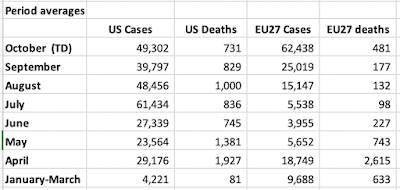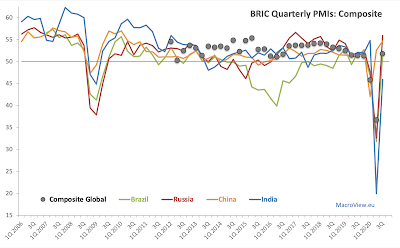In two previous posts, I have updated data for COVID19 pandemic through October 16 for:
- Global cases and deaths: https://trueeconomics.blogspot.com/2020/10/161020-covid19-update-worldwide-cases.html
- Countries with > 100,000 cases: https://trueeconomics.blogspot.com/2020/10/161020-covid19-update-countries-with.html
- The EU27 are now experiencing a full-blown second wave of infections. As the result, over October 1-16, EU27 new case numbers have surpassed the U.S. on 14 occasions and deaths on 3 occasions.
- The above development is extremely alarming. As the first chart shows, EU27 is setting new records in total numbers of daily cases, records that are running at a rate of 3 times higher daily new cases counts that at the peak of the first wave of the pandemic. This will, inevitably, translate into higher levels of deaths in weeks to come. More ominously, current rates of new cases arrivals in the EU27 are bound to overwhelm the healthcare systems of the member states.
- Meanwhile, the U.S. is also seeing increases in new cases, having enjoyed a temporary and short relief from the peak of the second wave around the end of the second week in September. Since then, the U.S. new cases are running at accelerating rates once again.
- In other words, it is time to call the third wave of the pandemic in the U.S.
- Deaths are also on a rising trend, in Europe, while lagging new cases explosion in the U.S.
- EU27 daily deaths counts are running at the rates more than double of September, more than 3.5 times the rates of August. October so far is the fourth deadliest month in this pandemic for the European Union.
- U.S. daily deaths are the pandemic lows, but still significantly above those in the EEU27.
- The U.S. has a vastly higher death rate per 1 million population than the EU27 rate: Current death rate per 1 million of population in the U.S. is 665.4 against the current death rate per 1 million of population in the EU27 is 347.9
- Put differently, current U.S. death rate per capita is 91 percent above that for the EU27.
- Overall counts of deaths in the U.S. are now above the EU27, since July 12. Current excess gap is at +66,037.
- Currently, adjusted for population and pandemic timing differences, the U.S. has 114,621 more deaths than the EU27.
- Meanwhile, owing to the second wave of the pandemic raging in Europe, EU27 member states are starting to go back into lockdown management mode.


































